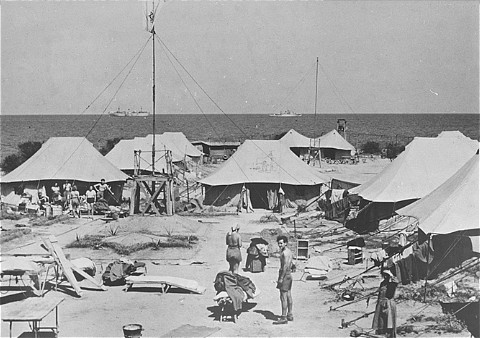
Cyprus Detention Camps
Between August 1946 and May 1948, the British government intercepted more than 50,000 Holocaust survivors seeking to resettle in Palestine. They interned these survivors in detention camps established on the Mediterranean island of Cyprus.
Key Facts
-
1
The British government created the camps on Cyprus as part of its effort to stem the rising tide of illegal immigration to Palestine organized by the Zionist movement’s Ha’apala or Aliya Bet ("illegal" immigration) campaign.
-
2
Nearly all the detainees were Holocaust survivors. Many had fled from Eastern Europe or the Soviet Union with the help of the underground Brihah movement. The Cyprus detainees sailed on 39 ships from ports in France, Italy, and the Balkans following long and arduous journeys from the DP camps in Germany and Austria.
-
3
Following the establishment of the state of Israel in May 1948, the Cyprus detention camps ceased operation (the last closed in February 1949) and the detainees made their way to the newly created state.
Population of the Camps
In all, the British detained about 52,000 ma’apilim (illegal immigrants) on Cyprus, including about 1,300 from North Africa. The Cyprus detainees were primarily young people who had joined Zionist youth groups before departing Europe. Approximately 80 percent were aged 12 to 35, while 8,000 were between the ages of 12 and 18. The majority were orphans.
The mossad l’aliyah bet branch of the Hagana (an underground Jewish military organization) was responsible for organizing the illegal immigration movement. It was most interested in recruiting young and hardy immigrants who were dedicated to the Zionist cause and capable of participating in the struggle to create a Jewish state. The mossad l’aliyah bet relied upon the Zionist youth movements in the displaced persons camps of central Europe—Hashomer Hatzair, Dror, Gordoniah, Nocham, and Betar—to provide the immigrants. This arrangement determined the unique demographic make-up of the Cyprus camps. Despite the diverse political movements represented in the camps, the internees established a joint movement structure to represent their needs before the authorities.
Conditions in the camps
The British military ran the detention camps in accordance with the harsh model of the POW camp. Surrounded by barbed wire and watch towers, the camps were under constant guard. The Joint Distribution Committee provided for the welfare of the detainees, including supplying food and medical care, mitigating the hardships suffered by the detainees. JDC Cyprus director Morris Laub served as the representative of the detainees vis-a-vis the British authorities.

There were two types of refugee camps on Cyprus. Five summer camps (nos. 55, 60, 61, 62, 63) were located at Kraolos, near Famagusta. The detainees were housed in tents. Seven winter camps (nos. 64-70) were located at Dekalia. Housing there consisted of tin Nissen huts and some tents. After December 1946, the majority of the children and teenagers were placed in Camp 64, known as the youth village.

Conditions were generally harsh. People were squeezed into tents and tin huts that were unbearably hot in the summer and freezing cold in the rainy winter, with little furniture, no electric lighting, limited access to water, bad food, and poor sanitary conditions.
Approximately 2000 babies were born in the Cyprus camps. The births took place in the Jewish wing of the British military hospital in Nicosia. Four hundred Jews died during their internment on the island and were buried in the Margoa cemetery.
Failure of the Policy of Detention
The British were successful in apprehending most of the 70,000 illegal immigrants who embarked for Palestine. Nonetheless, as space for refugees on Cyprus became scarce and ships continued to sail from Europe carrying ma’apilim, it became apparent to the British that the policy of detention in Cyprus was not successful in deterring the Ha’apala movement. The conditions in the Cyprus detentions camps and the sight of Jewish Holocaust survivors being held behind barbed wire also excited widespread criticism of British handling of the problem of Jewish immigration to Palestine. The British decision to send the refugee ship Exodus 1947 back to Europe in July 1947 instead of detaining its passengers on Cyprus represented an admission of the failure of the Cyprus deterrent.
For most of those survivors interned on Cyprus, the experience only served to strengthen their resolve to reach Palestine, which they almost all did following the creation of Israel in May 1948.
Critical Thinking Questions
- What pressures and motivations may have informed the decisions of the refugees to try to illegally reach Palestine?
- What pressures and motivations were impacting British decision-makers facing the illegal immigration?
- What choices do governments have when refugees try to reach their territory despite laws and restrictions?

